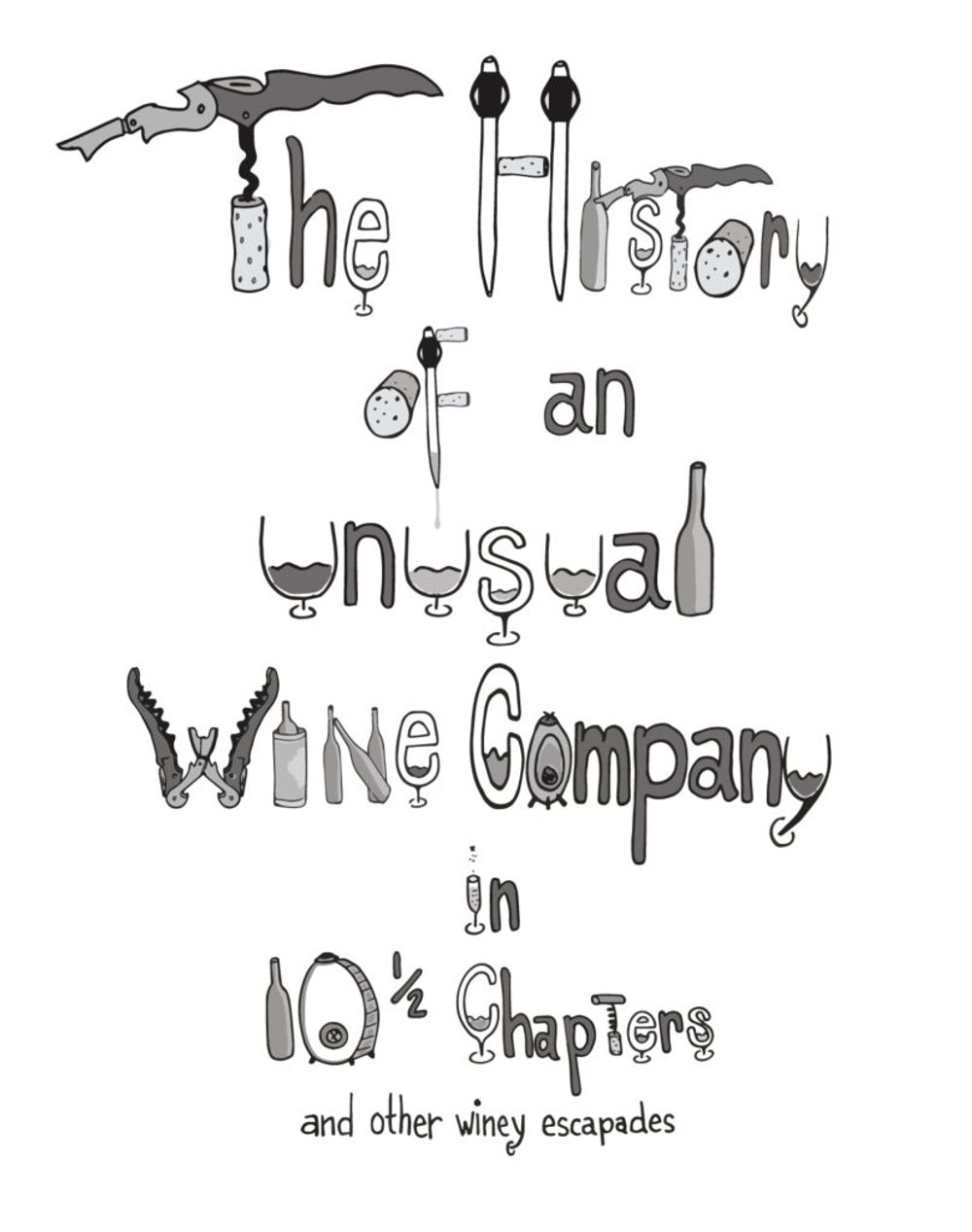Les Caves de Pyrène has achieved so much in the last 30 years that it has taken Doug Wregg 10 and a 1/2 chapters to tell its story.
A few years ago, at The Real Wine Fair, I was minding the beeswax on a bottle of expensive natural Beaujolais, when one of our trade customers came up to me and said: “If you ever published your text list (aka “the bible”, aka the encyclical draft-excluder), I would buy it!”
I laughed that off; people do say things like: “If you build it, they will come”.Or, “I’m your number one fan”. And other movie references. One person confided to me that he read the list in the bath. Really? That’s 400-pages of soppy soapy wine lis. Whilst another fan apparently kept it by the loo (which sounded a lot more probable – and functional). I simpered, as always, and did nothing.

As Doug Wregg lives and breathes Les Caves de Pyrène, who better to write its story?
At the beginning of last year, Les Caves de Pyrène was rising 30, and I suddenly thought it would be nice to recognise the considerable journey that we had made since 1988 when Les Caves– or Santat as it was then – was but three blokes, one woman, a pot plant and a (battered) van. To our present status as an apparently internationally-renowned wine company, with fingers poking into various small business pies across the globe.
I did not intend to boast about the greater glory of our business success, and describe how a sprat became a middling-sized sardine, instead I wanted to relay the accidental nature of progress from being that wee niche company of close mates to an operation that now employs (indirectly) around 150 people worldwide, and bear witness to how the wine business has changed since the innocent late 1980s.
‘A story of mentors and friends’

I got distracted. And this history, consequently, is not a sequential story so much as a series of random anecdotes. And numerous digressions. And bad jokes. And worse puns. And all the high and low cultural references that you could cram into Nebuchadnezzar of prose.
Subject-wise, the history of the wine company is very much about its wines, and even more so about the growers whom it imports and has relationships with. It is also about charting the development of our collective palate. And it is the whole real/natural wine debate in ever increasing sizes of nutshells.
In the end, it is about all the things that a certain wine company does – from buying and selling the stuff, to opening wine bars, organising the Real Wine Fair, creating sister companies and partnerships, and establishing a business direction and a presence in the market. It is a story of mentors and friends, of places and wine epiphanies, and a thousand and one other abstract ideas that wine impinges on and that impinge upon our wine education.
It is necessarily a partial and personal account, rather than an authorised biography, nor is it representative of the opinions of a wine company (if a wine company has opinions) and so it transpires to become basically a bit of a love letter to Les Caves and to the wine world that has given me a living.
(To give you an idea of what you can expect in Doug Wregg’s History of an Unusual Wine Company in 10 and a 1/2 Chapters he has kindly shared one of the half chapters with The Buyer. Details of how to buy the book are at the end.)

One of the many great illustrations in the book
Book Extract: From Chapter Seven
Melonator 3: Rise of the Muscadet.
The power of the self-fulfilling prophecy. You help it to come to pass by dint of saying that it has come to pass. You can’t do this with every wine, naturally. Pacherenc is never going to fly off the shelf unless people recall Mrs General’s improving dictum on pronunciation in Little Dorrit – namely that papa, potatoes, poultry, prunes, Pacherenc and prism are all words that are properly good for the lips. Nor have I been able to bring Thierry Navarre’s Ribeyrenc Noir to mainstream wine consciousness despite attempts at mass-hypnosis and positing that it was the next big thing since sliced Sauvignon, but I like to think that we were at the forefront of /to blame for (delete) the success of various now universally-popular wines.
Back into our Tardis to the time when people thought that Picpoul was choosing a nice place to swim. When we started shipping Château de la Mirande (a renowned Picpoul de Pinet), there were only a couple of wishy-washy versions of this southern French crisp quaffer doing the restaurant rounds. Little did we know that the little lip-stinger would become our biggest selling white wine.

How? A blend of native cunning, crunchy price, persiflage, appeal to aspiration and conjuring up pleasing wine myths. How else does one nail wine trends?
We focused on its natural habitat, the gastropub.
“‘A good Picpoul’, he expounds authoritatively, ‘should be crisp and full at the same time. That’s how the grape got its name: pic as in piquer – to prick – and poul as in poul. (A blank look from me.) ‘An old Occitan word meaning soft and rounded,’ he elaborates, as if he thought everyone fluent in the medieval language of the troubadour poets. But the closet etymologist soon gives way to the more familiar bibulous incarnation, when a second and a third bottle measures up to expectations.” – Virgile’s Vineyard – Patrick Moon
If I said huitres once, I said it a thousand times with lashings of mignonette in my voice. I also flannelled like crazy and made extravagant statements such as “This is what today’s youth are drinking in the wine bars in Béziers.” I made the broad assumption that there were youth in Béziers and they liked nothing better than chugging Picpoul to beguile away their sun-drenched afternoons. The romance of drinking wine.
I also conjured a picture of thirsty Brits clambering on board the Luton-Béziers bivalve redeye, then hitting the Picpoul bars by an azure Med where the oyster feria was in full shuck.
Andrew Jefford says certain wines tend to sell on the purchaser’s memory of “love on a bed of pine needles rather than the lure of raw flavour”. He was referring to Provençale rosés, but we can all dance to the memory of plateaux des fruits de mer, enjoyed by the sea with something crisp and saline. Unless you are allergic to seafood, in which case skip over the last bit and stick to making love on the pine needles.

To seal its reputation, we called Picpoul “The Muscadet of the South”. That was hardly original, but it gave corroborative verisimilitude to our previous bald and unconvincing sales narrative. When we had exhausted this analogy, we flipped it, and called Muscadet “The Picpoul of the North”. Always recycle your clichés when you’re selling wine.
The Muscadet trend, meanwhile, kept on trending, the quality of the wines improved and the Muscadet panegyrics on our list became yet more whimsical. Describing the more complex single vineyard expressions of wine from Pierre Luneau:
The poet Andrew Marvell wrote “Stumbling on melons, as I pass…” We warrant he never stumbled across a melon like this! This single vineyard Muscadet has an amazing, almost exotic nose of acacia-blossom and lime-flower and fills the palate with layer upon layer of “bread-and-butter” fruit. The yeasty sour-dough smokiness lingers hauntingly and the length would grace a premier cru Burgundy. Possessor already of superb single and cru locations, they have now brought a spectacular new vineyard on stream. Finally, the cuvée, La Butte de la Roche – planted on the exposed slopes of a hill that rises steeply out of the marshes the vines are on a fascinating iron-rich serpentite and magnetite soils caused by gradual metamorphic transformations. This terroir imparts terrific complexity to the wine which is initially taut with cool oyster-shell notes before unveiling more complex aromas of salt butter, gorse blossom and river stone and a palate bound together by soothing acidity. Truly the DRC of Melon de Bourgogne, the 1er Mousquetaire of Muscadet.
From the histrionic Les Caves de Pyrène text wine catalogue.
Finally, you know a trend has reached its apex, when so-called experts are invited to a round table debate about the matter in hand. And so it came to pass.
- Doug Wregg’s History of an Unusual Wine Company in 10 and a 1/2 Chapters is available to buy now from the Les Caves de Pyrene shop – shop@lescaves.co.uk – orhttps://shop.lescaves.co.uk/lescaves-shopfront. All profits will be going to charity.










































